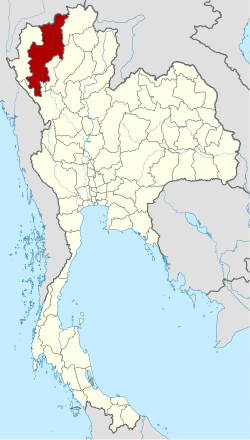Chiang Mai province
Chiang Mai (Thai เชียงใหม่) is the second-largest province (changwat) of Thailand. It is in the country's north. It is bordered by Chiang Rai to the northeast, Lampang and Lamphun to the south, Tak to the southwest, Mae Hong Son to the west, and Shan State of Burma to the north. The capital, Chiang Mai, is 685 km north of Bangkok.
Chiang Mai | |
|---|---|
| เชียงใหม่ | |
 | |
| Coordinates: 18°50′14″N 98°58′14″E / 18.83722°N 98.97056°E | |
| Capital | Chiang Mai |
| Government | |
| • Governor | Wichian Puttiwinyu (since 2013) |
| Area | |
| • Province | 20,107 km2 (7,763 sq mi) |
| Population (2014) | |
| • Province | 1,678,284[1] |
| • Urban | 960,906 |
| Human Development Index | |
| • HDI (2010) | 0.792 (high) (rank?) |
| Postal code | 50xxx |
| Calling code | 053 |
| Vehicle registration | เชียงใหม่ |
| Accession into Siam (Thailand) | 1910 |
| Website | http://www.chiangmai.go.th |
Geography
changeChiang Mai Province is about 685 km (426 mi) from Bangkok. The highest mountain in Thailand, Doi Inthanon at 2,565 metres (8,415 ft), is in Chiang Mai Province.[2]
Several other national parks are also in the province: Doi Suthep-Pui,[3] Ob Luang,[4] Sri Lanna,[5] Huai Nam Dang,[6] Mae Wang,[7] and Pha Daeng.[8]
History
changeThe city of Chiang Mai was capital of the Lanna Kingdom after its founding in 1296.[9]
In 1599, the kingdom lost its independence and became part of the Ayutthaya Kingdom.
In 1932, the province Chiang Mai moved up to the second level subdivision of Thailand when the administrative unit of Monthon Phayap, the remains of the Lanna Kingdom, was dissolved.
Types of People
change13.4% of the population in the province are members of hill tribes, among them the Hmong, Yao, Lahu, Lisu, Akha, and Karen.
Climate
changeChiang Mai has a tropical wet and dry climate (Köppen Aw), tempered by the low latitude and moderate elevation, with warm to hot weather year-round, though nighttime conditions during the dry season can be cool and are much lower than daytime highs. The maximum temperature ever recorded is 42.4 °C in May 2005.[10]
Transportation
change- Car. Chiang Mai is on Highway 11 (Super Highway Rd).
- Train. Chiang Mai is the northern terminus of the northern railway route.
- Songthaew
- Samlor. Samlors (rickshaws) can be found in the urban core.
- Tuk-tuks are used for short distances.
- Buses. Chiang Mai is served by buses from Bangkok and many other cities.
- Bicycle and motorbike. Both forms of transport can be hired in Chiang Mai city.
- Air. Chiang Mai International Airport (CNX) is one of the seven Thai international airports
References
change- ↑ "Population of the Kingdom" (PDF). Department of Provincial Affairs (DOPA) Thailand (in Thai). 2014-12-31. Retrieved 19 Mar 2015.
- ↑ "Doi Inthanon National Park". Tourist Authority of Thailand (TAT). Archived from the original on 1 May 2015. Retrieved 21 Mar 2015.
- ↑ "Doi Suthep-Pui National Park". Department of National Parks (DNP) Thailand. Archived from the original on 24 May 2015. Retrieved 24 May 2015.
- ↑ "Ob Luang National Park". Department of National Parks (DNP) Thailand. Archived from the original on 9 November 2013. Retrieved 24 May 2015.
- ↑ "Si Lanna National Park". Department of National Parks (DNP) Thailand. Archived from the original on 24 May 2015. Retrieved 24 May 2015.
- ↑ "Huai Nam Dang National Park". Tourism Authority of Thailand (TAT). Archived from the original on 2 April 2015. Retrieved 21 Mar 2015.
- ↑ "Mae Wang National Park". Department of National Parks (DNP) Thailand. Archived from the original on 12 February 2015. Retrieved 24 May 2015.
- ↑ "Pha Daeng National Park". Department of National Parks (DNP) Thailand. Archived from the original on 24 May 2015. Retrieved 24 May 2015.
- ↑ "Chiang Mai". Tourism Authority of Thailand (TAT). Archived from the original on 30 March 2015. Retrieved 21 Mar 2015.
- ↑ "Daily Climate Weather Data Statistics". Geodata.us. Archived from the original on 2013-06-16. Retrieved 2012-04-29.

